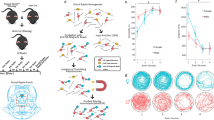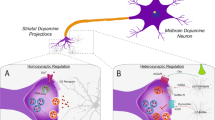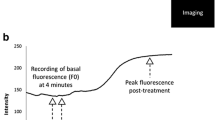Abstract
We previously found that ovarian steroids promote neuroprotection in serotonin neurons by decreasing the expression of pro-apoptotic genes and proteins in the dorsal raphe nucleus of rhesus macaques, even in the absence of overt injury. In this study, we questioned whether these actions would lead to a reduction in DNA fragmentation in serotonin neurons. Ovariectomized (OVX) rhesus monkeys were implanted with silastic capsules that were empty (placebo) or containing estradiol (E), progesterone (P) or estradiol and progesterone (E+P) for 1 month. In all animals, eight levels of the dorsal raphe nucleus in a rostral-to-caudal direction were immunostained using the terminal deoxynucleotidyl transferase nick end labeling (TUNEL) method. Two staining patterns were observed, which are referred to as type I, with complete dark staining of the nucleus, and type II, with peripheral staining in the perinuclear area. A montage of the dorsal raphe was created at each level with a Marianas Stereology Microscope and Slidebook 4.2, and the TUNEL-positive cells were counted. In direct comparison with OVX animals, P treatment and E+P treatment significantly reduced the total number of TUNEL-positive cells (Mann–Whitney test, both treatments P=0.04) and E+P treatment reduced the number of TUNEL-positive cells per mm3 (Mann–Whitney test, P=0.04). Double immunocytochemistry for TUNEL and tryptophan hydroxylase (TPH) indicated that DNA fragmentation was prominent in serotonin neurons. These data suggest that in the absence of ovarian steroids, a cascade of gene and protein expression leads to an increase in DNA fragmentation in serotonin neurons. Conversely, ovarian steroids have a neuroprotective role in the non-injured brain and prevent DNA fragmentation and cell death in serotonin neurons of nonhuman primates.
This is a preview of subscription content, access via your institution
Access options
Subscribe to this journal
Receive 12 print issues and online access
$259.00 per year
only $21.58 per issue
Buy this article
- Purchase on Springer Link
- Instant access to full article PDF
Prices may be subject to local taxes which are calculated during checkout





Similar content being viewed by others
References
Simpkins JW, Yang SH, Wen Y, Singh M . Estrogens, progestins, menopause and neurodegeneration: basic and clinical studies. Cell Mol Life Sci 2005; 62: 271–280.
Singh M, Dykens JA, Simpkins JW . Novel mechanisms for estrogen-induced neuroprotection. Exp Biol Med (Maywood) 2006; 231: 514–521.
Suzuki S, Brown CM, Wise PM . Mechanisms of neuroprotection by estrogen. Endocrine 2006; 29: 209–215.
Isacson O . On neuronal health. Trends Neurosci 1993; 16: 306–308.
Manji HK, Duman RS . Impairments of neuroplasticity and cellular resilience in severe mood disorders: implications for the development of novel therapeutics. Psychopharmacol Bull 2001. Spring 35: 5–49.
Teeling JL, Perry VH . Systemic infection and inflammation in acute CNS injury and chronic neurodegeneration: underlying mechanisms. Neuroscience 2009; 158: 1062–1073.
Tejani-Butt SM, Yang J, Pawlyk AC . Altered serotonin transporter sites in Alzheimer′s disease raphe and hippocampus. NeuroReport 1995; 6: 1207–1210.
Benninghoff J, Schmitt A, Mossner R, Kesch K-P . When cells become depressed: focus on neural stems cells in novel treatment strategies against depression. J Neural Transm 2002; 109: 947–962.
McEwen BS . Stress and hippocampal plasticity. Annu Rev Neurosci 1999; 22: 105–122.
Kerr JF, Wyllie AH, Currie AR . Apoptosis: a basic biological phenomenon with wide-ranging implications in tissue kinetics. Br J Cancer 1972; 26: 239–257.
Peter ME, Heufelder AE, Hengartner MO . Advances in apoptosis research. Proc Natl Acad Sci USA 1997; 94: 12736–12737.
Gorman AM, Orrenius S, Ceccatelli S . Apoptosis in neuronal cells: role of caspases. NeuroReport 1998; 9: R49–R55.
Krantic S, Mechawar N, Reix S, Quirion R . Apoptosis-inducing factor: a matter of neuron life and death. Prog Neurobiol 2007; 81: 179–196.
Fuchs E, Czeh B, Kole MH, Michaelis T, Lucassen PJ . Alterations of neuroplasticity in depression: the hippocampus and beyond. Eur Neuropsychopharmacol 2004; 14 (Suppl 5): S481–S490.
Bethea CL, Centeno ML, Cameron JL . Neurobiology of stress-induced reproductive dysfunction in female macaques. Mol Neurobiol 2008; 38: 199–230.
Gundlah C, Lu NZ, Mirkes SJ, Bethea CL . Estrogen receptor beta (ERβ) mRNA and protein in serotonin neurons of macaques. Mol Brain Res 2001; 91: 14–22.
Bethea CL . Colocalization of progestin receptors with serotonin in raphe neurons of macaque. Neuroendocrinology 1993; 57: 1–6.
Bethea CL, Lu NZ, Gundlah C, Streicher JM . Diverse actions of ovarian steroids in the serotonin neural system. Front Neuroendocrinol 2002; 23: 41–100.
Lu NZ, Bethea CL . Ovarian steroid regulation of 5HT1A receptor binding and G protein activation in female monkeys. Neuropsychopharmacology 2002; 27: 12–24.
Lu NZ, Eshleman AJ, Janowsky A, Bethea CL . Ovarian steroid regulation of serotonin reuptake transporter (SERT) binding, distribution and function in female macaques. Mol Psychiatry 2003; 8: 353–360.
Reddy AP, Bethea CL . Preliminary array analysis reveals novel genes regulated by ovarian steroids in the monkey raphe region. Psychopharmacology (Berl) 2005; 180: 125–140.
Bethea C, Reddy A . Effect of ovarian hormones on survival genes in laser captured serotonin neurons from macaques. J Neurochem 2008; 105: 1129–1143.
Tokuyama Y, Reddy A, Bethea C . Neuroprotective actions of ovarian hormones without insult in the raphe region of rhesus macaques. Neuroscience 2008; 154: 720–731.
Paxinos G, Huang X-F, Toga AW . The Rhesus Monkey Brain in Stereotaxic Coordinates. Academic Press: New York, 2000.
Chang GQ, Hao Y, Wong F . Apoptosis: final common pathway of photoreceptor death in rd, rds, and rhodopsin mutant mice. Neuron 1993; 11: 595–605.
Conti AC, Raghupathi R, Trojanowski JQ, McIntosh TK . Experimental brain injury induces regionally distinct apoptosis during the acute and delayed post-traumatic period. J Neurosci 1998; 18: 5663–5672.
Bethea CL, Streicher JM, Mirkes SJ, Sanchez RL, Reddy AP, Cameron JL . Serotonin-related gene expression in female monkeys with individual sensitivity to stress. Neuroscience 2005; 132: 151–166.
Rink A, Fung KM, Trojanowski JQ, Lee VM, Neugebauer E, McIntosh TK . Evidence of apoptotic cell death after experimental traumatic brain injury in the rat. Am J Pathol 1995; 147: 1575–1583.
Piantadosi CA, Zhang J, Levin ED, Folz RJ, Schmechel DE . Apoptosis and delayed neuronal damage after carbon monoxide poisoning in the rat. Exp Neurol 1997; 147: 103–114.
Wei L, Ying DJ, Cui L, Langsdorf J, Yu SP . Necrosis, apoptosis and hybrid death in the cortex and thalamus after barrel cortex ischemia in rats. Brain Res 2004; 1022: 54–61.
Springer JE . Apoptotic cell death following traumatic injury to the central nervous system. J Biochem Mol Biol 2002; 35: 94–105.
Cheng EH, Kirsch DG, Clem RJ, Ravi R, Kastan MB, Bedi A et al. Conversion of Bcl-2 to a Bax-like death effector by caspases. Science 1997; 278: 1966–1968.
Clark RS, Kochanek PM, Watkins SC, Chen M, Dixon CE, Seidberg NA et al. Caspase-3 mediated neuronal death after traumatic brain injury in rats. J Neurochem 2000; 74: 740–753.
Citron BA, Arnold PM, Sebastian C, Qin F, Malladi S, Ameenuddin S et al. Rapid upregulation of caspase-3 in rat spinal cord after injury: mRNA, protein, and cellular localization correlates with apoptotic cell death. Exp Neurol 2000; 166: 213–226.
Eldadah BA, Faden AI . Caspase pathways, neuronal apoptosis, and CNS injury. J Neurotrauma 2000; 17: 811–829.
Alkayed NJ, Goto S, Sugo N, Joh HD, Klaus J, Crain BJ et al. Estrogen and Bcl-2: gene induction and effect of transgene in experimental stroke. J Neurosci 2001; 21: 7543–7550.
Garcia-Segura LM, Cardona-Gomez P, Naftolin F, Chowen JA . Estradiol upregulates Bcl-2 expression in adult brain neurons. NeuroReport 1998; 9: 593–597.
Yao M, Nguyen TV, Pike CJ . Estrogen regulates Bcl-w and Bim expression: role in protection against beta-amyloid peptide-induced neuronal death. J Neurosci 2007; 27: 1422–1433.
Nilsen J, Brinton RB . Impact of progestins on estrogen-induced neuroprotection: synergy by progesterone and 19-norprogesterone and antagonism by medroxyprogesterone acetate. Endocrinology 2002; 143: 205–212.
Hoffman GE, Merchenthaler I, Zup SL . Neuroprotection by ovarian hormones in animal models of neurological disease. Endocrine 2006; 29: 217–231.
McCullough LD, Alkayed NJ, Traystman RJ, Williams MJ, Hurn PD . Postischemic estrogen reduces hypoperfusion and secondary ischemia after experimental stroke. Stroke 2001; 32: 796–802.
Faubel S, Edelstein CL . Caspases as drug targets in ischemic organ injury. Curr Drug Targets Immune Endocr Metabol Disord 2005; 5: 269–287.
Jover-Mengual T, Zukin RS, Etgen AM . MAPK signaling is critical to estradiol protection of CA1 neurons in global ischemia. Endocrinology 2007; 148: 1131–1143.
Corasaniti MT, Amantea D, Russo R, Piccirilli S, Leta A, Corazzari M et al. 17beta-estradiol reduces neuronal apoptosis induced by HIV-1 gp120 in the neocortex of rat. Neurotoxicology 2005; 26: 893–903.
Schmidt PJ, Nieman L, Danaceau MA, Tobin MB, Roca CA, Murphy JH et al. Estrogen replacement in perimenopause-related depression: a preliminary report. Am J Obstet Gynecol 2000; 183: 414–420.
Frey BN, Lord C, Soares CN . Depression during menopausal transition: a review of treatment strategies and pathophysiological correlates. Menopause Int 2008; 14: 123–128.
Espeland MA, Rapp SR, Shumaker SA, Brunner R, Manson JE, Sherwin BB et al. Conjugated equine estrogens and global cognitive function in postmenopausal women: Women′s Health Initiative Memory Study. JAMA 2004; 291: 2959–2968.
Zhao L, O′Neill K, Diaz Brinton R . Selective estrogen receptor modulators (SERMs) for the brain: current status and remaining challenges for developing neuroSERMs. Brain Res Brain Res Rev 2005; 49: 472–493.
Brinton RD . Investigative models for determining hormone therapy-induced outcomes in brain: evidence in support of a healthy cell bias of estrogen action. Ann N Y Acad Sci 2005; 1052: 57–74.
Schumacher M, Guennoun R, Stein DG, De Nicola AF . Progesterone: therapeutic opportunities for neuroprotection and myelin repair. Pharmacol Ther 2007; 116: 77–106.
Galani R, Hoffman SW, Stein DG . Effects of the duration of progesterone treatment on the resolution of cerebral edema induced by cortical contusions in rats. Restor Neurol Neurosci 2001; 18: 161–166.
Cutler SM, VanLandingham JW, Murphy AZ, Stein DG . Slow-release and injected progesterone treatments enhance acute recovery after traumatic brain injury. Pharmacol Biochem Behav 2006; 84: 420–428.
Gibson CL, Murphy SP . Progesterone enhances functional recovery after middle cerebral artery occlusion in male mice. J Cereb Blood Flow Metab 2004; 24: 805–813.
Djebaili M, Guo Q, Pettus EH, Hoffman SW, Stein DG . The neurosteroids progesterone and allopregnanolone reduce cell death, gliosis, and functional deficits after traumatic brain injury in rats. J Neurotrauma 2005; 22: 106–118.
Gonzalez-Vidal MD, Cervera-Gaviria M, Ruelas R, Escobar A, Morali G, Cervantes M . Progesterone: protective effects on the cat hippocampal neuronal damage due to acute global cerebral ischemia. Arch Med Res 1998, Summer 29: 117–124.
Cervantes M, Gonzalez-Vidal MD, Ruelas R, Escobar A, Morali G . Neuroprotective effects of progesterone on damage elicited by acute global cerebral ischemia in neurons of the caudate nucleus. Arch Med Res 2002; 33: 6–14.
Garcia-Segura LM, Azcoitia I, DonCarlos LL . Neuroprotection by estradiol. Prog Neurobiol 2001; 63: 29–60.
Bethea CL . Regulation of progestin receptors in raphe neurons of steroid-treated monkeys. Neuroendocrinology 1994; 60: 50–61.
Shughrue PJ, Lane MV, Merchenthaler I . Regulation of progesterone receptor messenger ribonucleic acid in the rat medial preoptic nucleus by estrogenic and antiestrogenic compounds: an in situ hybridization study. Endocrinology 1997; 138: 5476–5484.
Bethea CL, Reddy AP, Smith LJ . Nuclear factor kappa B in the dorsal raphe of macaques: an anatomical link for steroids, cytokines and serotonin. J Psychiatry Neurosci 2006; 31: 105–114.
Maggi A, Ciana P, Belcredito S, Vegeto E . Estrogens in the nervous system: mechanisms and nonreproductive functions. Annu Rev Physiol 2004; 66: 291–313.
Tatton WG, Chalmers-Redman R, Brown D, Tatton N . Apoptosis in Parkinson's disease: signals for neuronal degradation. Ann Neurol 2003; 53 (Suppl 3): S61–S70; discussion S70-62.
Acknowledgements
We are deeply grateful to the dedicated staff of the Division of Animal Resources, including the staff of the Departments of Surgery and Pathology, for their expertise and helpfulness in all aspects of monkey management. We especially thank Dr Jessica Henderson for cutting the midbrain brain blocks and organizing the sections. We are indebted to the Endocrine Services Laboratory for radioimmunoassay of steroid hormones. This research was supported by the National Institutes of Health Grants MH 62677 (to CLB), and Grants U54-HD18185 and RR00163 in support of the Oregon National Primate Research Center.
Author information
Authors and Affiliations
Corresponding author
Ethics declarations
Competing interests
The authors declare no conflict of interest.
Rights and permissions
About this article
Cite this article
Lima, F., Bethea, C. Ovarian Steroids Decrease DNA Fragmentation in the Serotonin Neurons of Non-Injured Rhesus Macaques. Mol Psychiatry 15, 657–668 (2010). https://doi.org/10.1038/mp.2009.97
Received:
Revised:
Accepted:
Published:
Issue Date:
DOI: https://doi.org/10.1038/mp.2009.97
Keywords
This article is cited by
-
Ovarian steroids regulate gene expression related to DNA repair and neurodegenerative diseases in serotonin neurons of macaques
Molecular Psychiatry (2015)
-
Sex differences and stress across the lifespan
Nature Neuroscience (2015)



